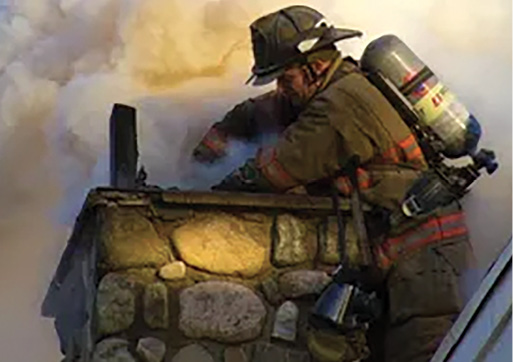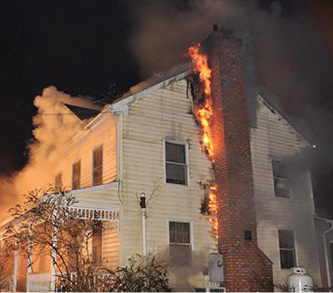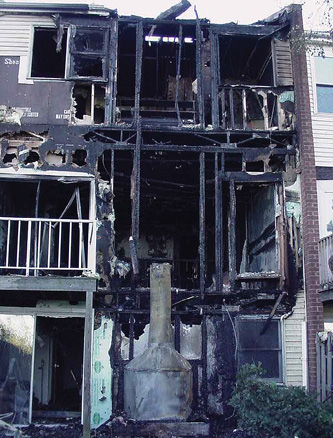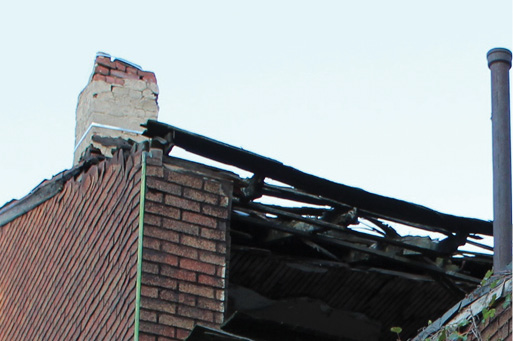
TRAINING NOTEBOOK ❘ By Brian Butler
Chimney fires are rare. For this reason, we should review our tactics for mitigating them every year to ensure a quick, effective coordinated attack and to prevent them from becoming all-out structure fires.
Chimneys are vertical structures that ventilate smoke or hot gases from boilers, oil burners, fireplaces, stoves, and furnaces to the outside atmosphere. The inside of a chimney is called the “flue,” which is a duct or a pipe that exhausts smoke and gas from fireplaces, furnaces, water heaters, and so on. Chimneys have many uses, from burning wood to providing heat to venting an incinerator in a high-rise apartment building. We should prepare for fires involving the common types of chimneys in our response areas.
RELATED TRAINING
Tips on Extinguishing Chimney Fires That Improve Efficiency, Public Image
The Urban Attic Fire: An “Upside-Down” Basement Fire
My urban department in the Northeast has numerous row homes of ordinary and wood-frame construction, semidetached homes, high-rises, and taxpayers. Most chimney uses in the city are for oil heat with oil burners located in the basement or cellar. In the past 20 years, chimney fires have decreased greatly in the city because of reduced wood-burning fireplace use, the conversion of oil heat to gas heat, an increase in vacant structures, and community fire prevention campaigns. My metropolitan department responds mostly to wood-frame, single-family homes and noncombustible commercial and retail properties. The fire concern usually is fireplaces used for heat in single-family dwellings. They are usually on the first floor.
In general, regardless of region, all types of chimneys with various types of construction are located somewhere in your response area. Most are of brick/masonry and have tile, terra cotta, or metal flues. Older homes may not have a flue. Whether you are in an urban, a rural, or a suburban department, every year prior to chimney season (usually the fall), schedule a chimney fire training review. Make sure the engine and ladder company work together to control these fires early.

(1) A chimney fire penetrates the liner and extends to the structure. (Photo courtesy of Steven Roth.)
Potential Fire Hazards
A reported chimney fire should require a structure assignment response; additional personnel will be needed to effectively mitigate a chimney fire. Most chimney fires are contained fires, but if they are not controlled quickly, they can extend to the roof, cockloft, attic, and basement.
A volunteer assistant chief was seriously injured and two volunteer firefighters were injured while fighting a townhouse fire in Delaware (photos 2-3). The fire originated in a chimney in a walk-out basement of a town house unit and extended to floors and the attic through the “flue box” enclosure. The flue enclosure was interconnected with the spaces between the ceiling and the floors created by the parallel chord floor trusses. Conditions rapidly deteriorated, forcing firefighters to bail out of a window and quickly exit the structure. Firefighters suffered burns and smoke inhalation.1


(2-3) The townhouse fire in Delaware that seriously injured a volunteer assistant chief and injured two volunteer firefighters. (Photos courtesy of Centers of Disease Control and Prevention/National Institute for Occupational Safety and Health; https://www.cdc.gov/niosh/fire/reports/face200043.)html/).
Most chimney fires are caused by highly combustible creosote buildup in the flue. Cracks and openings in the flue that permit exposure to wooden structural components can also start a fire. Flames, sparks, and fast-moving dense smoke accompanied by a roaring sound are sure signs of a chimney fire. Chimney fires can burn up to 2,000°F, destroying liners, bricks, and masonry materials and contributing to fire spread in combustible parts of the structure. A well-coordinated effort will be needed to extinguish the chimney fire before it spreads to the rest of the structure.
Tactics for Mitigating a Chimney Fire
Engine Company
Stretch a line to the interior, and quickly determine the source—an oil burner, a fireplace, or a basement fire. Place salvage covers/floor runners in the area to prevent doing further damage to the property.
It is acceptable to use a water can to extinguish a small class A fire outside the fireplace, furnace, or stove. But, fires inside a chimney, fireplace, or furnace box may necessitate a dry chemical extinguisher, which will draw the powder upward.
Bring shovels, and place any smoldering creosote/wood/embers into a metal bucket; take the bucket outside for extinguishment.
Send a company to the attic/cockloft to check for extension.
Monitor carbon monoxide (CO) readings in the structure after the fire has been extinguished, and ventilate accordingly.
Ladder Company
Size up the chimney roof area for access and egress. It may take up to three types of ladders to access the top of the chimney. It may be safer to put up the aerial ladder or work off a platform.
Bring the chimney kit consisting of chimney sweep chains, a mirror, and a thermal imaging camera. Additional equipment such as hand tools/hooks, a flashlight, chimney bombs (dry chemical powder in bags), a pickhead ax, or a saw may be needed to dig out the roof area near the chimney.

(4) A firefighter works the chains during a chimney fire in Lake Placid, New York. (Photo by Tonya Woodard.)

(5) Use caution with unstable chimneys. (Photo by author.)
Remove the chimney cap, fencing (bird cage), and any other debris from the top of the chimney. Dropping the chimney bombs down the chimney is very effective; the bag will melt, with powder being naturally drawn up the chimney. Never look down the chimney when applying extinguishing agents!
Lower the weighted chimney chains from the top of the chimney down the flue to knock the creosote off the walls into the base container area, from which it will be removed and extinguished.
Check for extension at the base of the chimney near the flashing.
Collapse
The collapse of a chimney can seriously injure unsuspecting firefighters below. Most chimneys in older cities are in poor condition and are made of brick (photo 5). Most of these bricks are cracked and have lost the mortar between them and are being held up by gravity. Establish a collapse zone under the area of the chimney.
Using water to extinguish a chimney fire may cause spalling and further damage the chimney or crack the fire box in an oil burner. It is best to use dry chemical powder. If using a hoseline on the roof is your only option to extinguish a chimney fire, apply short bursts of water to the top.
Advise the property owner to have the chimney serviced/cleaned/repaired. Check the CO levels before leaving.
Endnotes
1. United States Product Safety Commission; https://www.cpsc.gov/s3fs-public/2011to2013ResidentialFireLossEstimates-Final.pdf
2. The National Institute for Occupational Safety and Health report is at: https://www.cdc.gov/niosh/fire/reports/face200043.html/.
BRIAN BUTLER is a captain assigned to Trenton (NJ) Fire Department Engine 10 and has been a member of the fire service for 22 years. He is a member of King of Prussia (PA) Fire Rescue, the Southeastern Pennsylvania Technical Rescue Task Force, and the Bucks County Hazmat Team. He is a rescue, heavy rescue, hazmat, confined space, and machinery/elevator rescue technician, a level 2 fire instructor, and an auto extrication technician and instructor. He is the owner of UrbanFireTraining.

